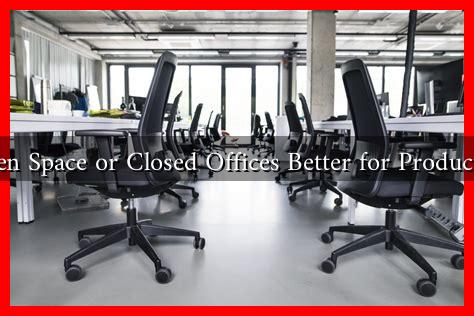-
Table of Contents
Is Open Space or Closed Offices Better for Productivity?
In recent years, the debate over open space versus closed office environments has gained significant traction among businesses and employees alike. As companies strive to enhance productivity, employee satisfaction, and collaboration, the choice of workspace design has become a critical factor. This article explores the advantages and disadvantages of both open spaces and closed offices, providing insights into which environment may be more conducive to productivity.
The Rise of Open Office Spaces
Open office layouts have become increasingly popular, especially in tech companies and startups. The primary goal of this design is to foster collaboration and communication among employees. Here are some key features and benefits of open office spaces:
- Enhanced Collaboration: Open spaces encourage spontaneous interactions and brainstorming sessions, which can lead to innovative ideas.
- Cost-Effective: These layouts often require less construction and can accommodate more employees in a smaller footprint.
- Flexibility: Open offices can be easily reconfigured to adapt to changing team sizes and project needs.
According to a study by the Harvard Business Review, companies that adopted open office designs saw a 20% increase in face-to-face interactions among employees. This suggests that open spaces can indeed foster collaboration, which is essential for creativity and problem-solving.
The Case for Closed Offices
On the other hand, closed offices offer a different set of advantages that can significantly impact productivity. These environments typically consist of private offices or cubicles that provide employees with a dedicated space to work. Here are some benefits of closed office designs:
- Reduced Distractions: Closed offices minimize noise and visual distractions, allowing employees to focus better on their tasks.
- Privacy: Employees can have confidential conversations or work on sensitive projects without interruptions.
- Personalization: Closed offices allow employees to personalize their workspace, which can enhance comfort and job satisfaction.
A study conducted by the University of Sydney found that employees in closed offices reported higher levels of job satisfaction and productivity compared to those in open spaces. This suggests that while collaboration is important, the need for focus and privacy cannot be overlooked.
Finding the Balance: Hybrid Workspaces
As the debate continues, many organizations are now exploring hybrid workspace models that combine elements of both open and closed office designs. This approach aims to provide the best of both worlds, allowing for collaboration while also accommodating the need for privacy and focus. Key features of hybrid workspaces include:
- Collaboration Zones: Designated areas for team meetings and brainstorming sessions.
- Quiet Rooms: Spaces where employees can retreat for focused work or private conversations.
- Flexible Workstations: Hot-desking options that allow employees to choose their workspace based on their daily tasks.
Companies like Google and Microsoft have successfully implemented hybrid models, resulting in increased employee satisfaction and productivity. By offering a variety of work environments, these organizations cater to different working styles and preferences.
Conclusion: The Best Environment for Productivity
Ultimately, the question of whether open spaces or closed offices are better for productivity does not have a one-size-fits-all answer. Each environment has its unique advantages and challenges. Open offices can enhance collaboration and communication, while closed offices provide the privacy and focus that some employees need to thrive.
As organizations continue to evolve, the trend towards hybrid workspaces appears to be a promising solution. By combining the strengths of both designs, companies can create an environment that fosters collaboration while also respecting individual work preferences. The key takeaway is that understanding the specific needs of your workforce and adapting the workspace accordingly can lead to improved productivity and employee satisfaction.
For further reading on workplace design and productivity, you can explore resources from the Harvard Business Review and the Forbes website.

